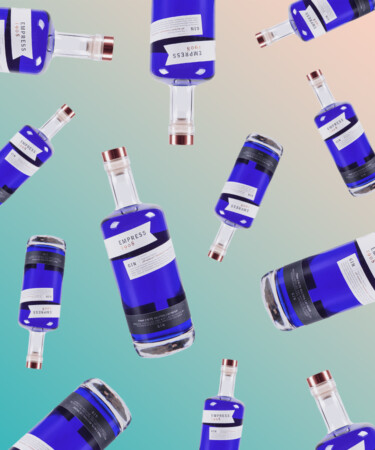If you’ve spotted a bottle with a striking violet hue on your local back bar, chances are it was Empress 1908’s flagship gin. Launched in 2017, the brand has grown to become the No. 1 super-premium gin brand in Canada. Soon after the gin’s release, purple drinks took the cocktail world by storm, and Empress could usually be found at the core of their builds.
Handcrafted in small-batch copper pot stills by Victoria Distillers, one of the oldest artisan distillers in British Columbia, Empress 1908 combines dynamic ingredients including a black tea blend and vibrant florals for a spirit that’s as colorful as it is versatile.
Now that you’ve learned the basics, here are more things you should know about Empress 1908 Gin, as well as the best Empress cocktails to sling at home.
-
Its flagship gin’s signature violet color is all-natural…
Rather than using food coloring to achieve the violet hue of its best-selling gin, Empress 1908 instead employs butterfly pea blossoms. This was somewhat of an accident: While testing the tea blend that would make it into the final version of the gin, distillers discovered that the blossom imparted a deep purple tint to the spirit. In addition to its hue, the plant offers deep, earthy notes that balance the traditional citrus-forward flavors in the spirit.
As there are no artificial colors added and no stabilizers used in the spirit, every bottle of Empress will begin to fade in color over time. Because of this, the brand recommends finishing each bottle of the gin within a year of purchase and storing it in a cool, dark environment as sunlight exposure expedites fading.
-
…and will transform depending on what you mix it with.
Butterfly pea blossoms contain compounds called anthocyanins that change color depending on the pH level of the substance they interact with. When they are in a neutral environment, like that of gin, they remain violet. When combined with an acidic substance, they’ll express as red or pink, and with more basic companions, they turn blue. According to former master distiller Peter Hunt, the team discovered this added benefit while developing recipes to feature at Victoria, B.C.’s 2017 Art of the Cocktail: The drinks containing acidic citrus juices skewed rosy, while cocktails that had been made with basic ingredients like cucumber turned a darker blue.
-
The spirit was inspired by an iconic hotel.
The Fairmont Empress Hotel opened on Victoria’s waterfront in 1908 and has served a luxury afternoon tea service ever since, along with a revolving selection of seasonal, hand-picked teas sourced from all over the world. When creating Empress, the distillers at Victoria Distilling took inspiration from the hotel and incorporated the legendary tea service into their brand’s identity. With that in mind, each batch of Empress 1908 Gin is made with the same black tea blend served at the Fairmont Empress.
-
Two of Empress’s ingredients are a nod to India.
Prior to India’s independence in 1950, the country’s residents referred to British kings and queens as emperors and empresses. In 1877, Queen Victoria (the namesake of Empress 1908’s home town) became the first Empress of India. As a nod to Canada’s commonwealth sibling, the brand included two of India’s most popular spices in its formula: cinnamon and ginger.
-
Empress eschews typical citrus.
While most gins on the market use citrus botanicals like lemon or orange in their blends, Empress is made with grapefruit peel instead. According to the brand, the ingredient provides a distinct aromatic experience and bittersweet herbal notes that pair well with gin’s preferred mixer, tonic.
-
Empress is committed to reducing its footprint.
Aware of the amounts of water and energy necessary to distill spirits, Victoria Distillers is committed to reducing its climate impact wherever possible. As such, the distillery partnered with its neighbor, the Sidney Pier Hotel, to use a closed-loop system during distillation that recaptures heat and water used in the distilling process and converts them to energy that’s used at the hotel next door. Through this system, Victoria Distillers is able to save approximately 1,500 gallons of water and is able to transfer 850,000 BTUs of energy to the hotel per distillation. Through this project, the distillery hopes to save 1,384,000 gallons of water per year.
-
In 2023, Empress launched a blushing new gin.
Empress’s new Elderflower Rose Gin launched in the U.S. in September 2023 in all its rose-tinted glory. Also handcrafted in small-batch copper pot stills, the gin is distilled using nine botanicals including juniper, rose petals, elderflower, lavender, orange peel, orris root, cinnamon, coriander, and black carrot. According to the brand, the spirit was inspired by its waterfront location in Victoria, which is widely regarded as the City of Gardens as many flowers remain in bloom almost year-round. Like its purple-hued sister, the color of Empress’s rose gin is also achieved naturally: Rose petals and black carrots provide the spirit with its vibrant ruby shade.
-
The Best Empress gin Cocktails.
If you’re looking to experiment with Empress Gin, the lavender-forward Indigo Thrill is a perfect place to start. The cocktail serves as a violet variation of the ever-popular Negroni, with Empress Gin, Cocchi Americano Blanc Vermouth, Salers Aperitif, and lavender bitters. And if bitter cocktails aren’t quite your style, the Purple Gin Coco marries the herbaceous purple gin with orange liqueur and toasted coconut syrup for a floral, nutty base. But if you’re a traditionalist and want to stick to your tried-and-true Vesper or G&T, good news: Empress can be swapped for any other gin in classic cocktails — your drink will just be prettier for it.
